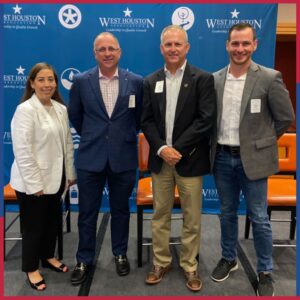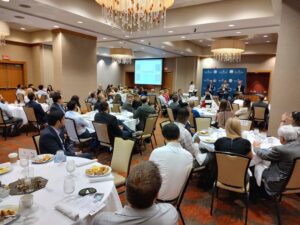Recognizing the challenges seen in aging water infrastructure across our region, the WHA Water Resources committee identified the opportunity to discuss how we can do things even better moving forward. This discussion transformed into our forum held on June 29th, 2023 titled Developing Resilient Water Infrastructure. The panel featured Rainer Ficken (Caldwell Companies) a developer who makes the critical investment to build a water plant, Taylor Reed (Vogler & Spencer Engineering) an engineer who designs and oversees construction of the water plant, and Jeff Haley (SiEnvironmental) a water operator who … perhaps obviously… operates the water plant on a day-to-day basis. The event was moderated by WHA Water Resources Committee Vice Chair, Melinda Salazar (BGE). Together, they made the case on how planning the right resources upfront can lead to more sustainable and resilient communities.

Melinda Salazar, Rainer Ficken, Jeff Haley, Taylor Reed
The panel began with a discussion of the resources a developer can provide at the beginning of planning and development to eliminate redundancies and be better equipped for unexpected or emergency situations. Discussion among the panelists quickly turned to generators and part suppliers.
When talking about resilience, one of the first things our panel agreed on is that “a generator is a must.” Not just during emergencies, but also as part of regular operation. Jeff Haley provided the example that the power company will say “I need four hours to get a repair done,” then two and half days later, the power is still out. The generator becomes a life saver. From the operator perspective, Jeff stressed that they “appreciate developers giving us the tools to get things done.”
From Taylor Reed’s experience, “when infrastructure starts to become dated, the real skeletons are exposed in how the facilities have been operating and the ability to rehabilitate them.” The struggle is on the wastewater side. Water facilities have the benefit of additional plants or interconnects with neighboring districts. Wastewater facilities on the other hand lack the ability to reroute the incoming flows. This usually results in costly “wet hauling” (hauling of unprocessed wastewater) to a different facility to be treated. Plants that have additional capacity or are designed in a way to divide flows, accordingly, afford a much more streamlined process for fixing issues.
Another issue discussed was repairs and parts. Rainer Ficken mentioned the struggles of dealing with systems coming from overseas. It could take months to get a replacement part and then when it does arrive there may only be a few people qualified to work on the system. Sometimes this means parts can’t be repaired and instead the result is a more expensive replacement.
 Next, the panel discussed the importance of designing something that meets the developer’s needs, and that the operator can work with. This starts with a discussion on the location and size for the site. Often the developer will want to use as small of a footprint as they can and put it in a place away from residents. However, those are not always feasible options. With the ever-changing guidelines from the City of Houston and TCEQ regarding the layout of water plants, time should be given to laying out the site, looking at future expansion needs such as a secondary GST or second well location. The same could be said for wastewater treatment facilities. Typically, Districts have a single wastewater facility or even a shared facility between multiple Districts. Therefore, it is important to consider what expansion will look like over time and how big the footprint will ultimately be.
Next, the panel discussed the importance of designing something that meets the developer’s needs, and that the operator can work with. This starts with a discussion on the location and size for the site. Often the developer will want to use as small of a footprint as they can and put it in a place away from residents. However, those are not always feasible options. With the ever-changing guidelines from the City of Houston and TCEQ regarding the layout of water plants, time should be given to laying out the site, looking at future expansion needs such as a secondary GST or second well location. The same could be said for wastewater treatment facilities. Typically, Districts have a single wastewater facility or even a shared facility between multiple Districts. Therefore, it is important to consider what expansion will look like over time and how big the footprint will ultimately be.
With some of the modern Master Planned Communities, the project could easily be 20+ years from start to finish. It is up to the engineering and operator community to maintain the system. This involves both tactical repairs and long-term planning. While small repairs may be necessary short term, it’s the long term (20-40 years) repairs and replacements that are more costly. Rainer pointed out that while the developer might be gone, their reputation is still present and important, emphasizing the need for upfront investment and “doing things right the first time.” The panel also discussed that there are better and worse ways to think about water and wastewater facilities in the long-term. A district should consider a phased approach to upgrades and replacement.
The panelists recognized that technology gets better and better each year. However, upgrading has its own challenges. The first is the cost. It is important for a district to have a Capital Improvement Plan because it would be too expensive to try to upgrade everything at one time. Then there are decisions about what parts of the system to upgrade. Should funds be spent on new smart meters for customers to better watch their personal usage and conserve water? Rainer mentioned that residents seem particularly interested in this technology. Smart meters can also reduce labor costs for the operators.
Or is it more important to replace old lines that might be at the end of their life expectancy and at risk of breaking? Another option is investment in new blowers that could cut electricity usage and costs. Or motor control centers linked with SCADA for more efficient facility operations. SCADA has the benefit of both reducing labor demands for lower day-to-day costs as well as increased resilience in times of emergency when getting to the site in person might be more difficult.
Jeff and Taylor reminded the audience that collaboration with the operators on what tools will be useful for them is critical. The older generation of operators are not as comfortable with new technology. While younger operators are being trained on SCADA and computers are part of their day-to-day life, older operators are used to turning knobs and flipping switches, as they have operated older technology plants built 20-40 years ago. While technology will make things easier in the years to come there is going to be a transition period.
 Kristen Rodriguez (Texas Water Trade) asked, “Is there enough water?” and “Is sustainable development being considered?” Rainer suggested that developers are looking at this issue especially in regard to water reuse and smart technology. Irrigation is one of the biggest uses of water. Many new developments are using purple pipe systems to reuse water for irrigation, some are using amenity ponds or lakes to store water for irrigation. There is also a push for efforts at the household level to encourage builders to use water wise technologies. There are a lot of hurdles faced by trying to do something on that scale in an established District. These Districts rarely have the lines in place to provide the reuse and space is very limited as to where the lines could potentially go. The treatment process required for reuse to be permitted for secondary use also takes up critical space at wastewater treatment facilities that are already limited and can be quite costly.
Kristen Rodriguez (Texas Water Trade) asked, “Is there enough water?” and “Is sustainable development being considered?” Rainer suggested that developers are looking at this issue especially in regard to water reuse and smart technology. Irrigation is one of the biggest uses of water. Many new developments are using purple pipe systems to reuse water for irrigation, some are using amenity ponds or lakes to store water for irrigation. There is also a push for efforts at the household level to encourage builders to use water wise technologies. There are a lot of hurdles faced by trying to do something on that scale in an established District. These Districts rarely have the lines in place to provide the reuse and space is very limited as to where the lines could potentially go. The treatment process required for reuse to be permitted for secondary use also takes up critical space at wastewater treatment facilities that are already limited and can be quite costly.
No discussion about wastewater would be complete without a question of (not so) “flushable” wipes. Wendy Duncan (Inframark) asked, “since changing behavior is difficult, is there an engineering solution?” Taylor discussed new screening technologies that are helping, but “these rags are resilient… they take a beating, but they still come out the other side.” While there are lots of things being tried, so far there is no simple solution.
The panel wrapped up with each panelist providing a quick take away. Rainer stressed, “do it right the first time.” Taylor focused on the idea of having a “Good capital improvement plan to educate board and planning for the future.” Jeff suggested, “Technology efficiencies, do more with less using new technology.”
